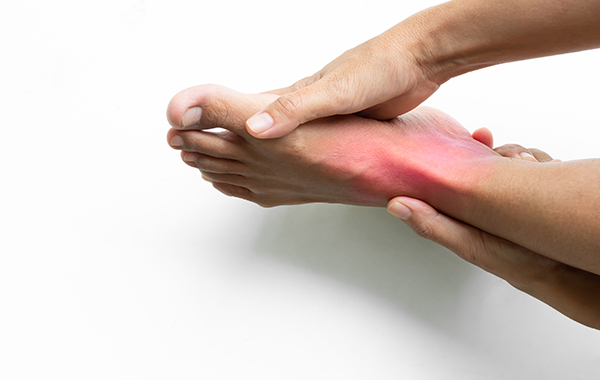What is Diabetic Neuropathy?
Diabetic neuropathy is a serious diabetes complication that may affect as many as 50% of people with diabetes. But you can often prevent diabetic neuropathy or slow its progress with consistent blood sugar management and a healthy lifestyle.
UNDERSTANDING DIABETIC NEUROPATHY
Overview
Diabetic neuropathy is a form of nerve damage that commonly affects individuals with diabetes, particularly impacting the nerves in the feet and legs. In its early stages, diabetic neuropathy may not show obvious signs or symptoms.
As the damage progresses over time , individuals with diabetes may experience sensations such as burning pain, tingling, and a loss of tactile sensation in the feet and hands. This reduced sensation poses a risk, as injuries like cuts, blisters, or ingrown toenails may go unnoticed, leading to potential complications.
If individuals have unaddressed wounds, it can fester and develop an infection which can spread rapidly, leading to serious conditions such as a gangrene. Gangrene is a condition that may lead to life-threatening complications like sepsis, a severe blood infection. Given the impaired ability of diabetic patients’ bodies to combat infections due to elevated blood sugar levels, there is an increased risk of amputation of the affected limb in cases of severe complications.

Types of Neuropathy
Peripheral symmetric neuropathy:
This primarily affects the nerves in the feet before progressing to the hands, representing the most common form of diabetic neuropathy.
Thoracic and lumbar root, or proximal neuropathy:
This damages nerves along specific distributions, such as the chest wall or legs.
Autonomic neuropathy:
This impacts the nerves controlling involuntary bodily functions like digestion, urination, and heart rate.
Mononeuropathy (focal neuropathy):
This targets a single individual nerve, resulting in localised pain, loss of movement, or numbness
Patients with diabetes may experience multiple types of neuropathy at the same time, with peripheral neuropathy and mononeuropathy being the most commonly observed forms in diabetic podiatric cases.
How Do Podiatrists Manage Diabetic Neuropathy?
While there is currently no cure for diabetic neuropathy, podiatrists employ a range of therapies aimed at slowing down its progression, addressing secondary conditions and alleviating pain. Individual responses to these interventions may vary based on factors like glucose control, vascular supply, and the extent of nerve deterioration. Your podiatrist will conduct recurrent, comprehensive diabetic foot examinations to monitor sensations and blood flow to the feet, ensuring timely intervention if deterioration is observed. They will also check for any emerging secondary conditions. Podiatric solutions for diabetic neuropathy include:
Preservation of Foot Shape and Function:
Custom foot orthotics or ankle-foot orthotics (AFOs) are made to maintain the shape and function of the feet, reducing fall risk and preventing deformation and collapse in diabetic feet. This facilitates patient mobility and activity.
Prevention and Wellness Management:
Establishing a comprehensive prevention and wellness plan that incorporates meticulous skin and nail care. Specialised wound care is important to minimise the risk of limb amputation.
In-Clinic Therapies:
Utilising advanced technologies like Super Inductive System (SIS) and Extracorporeal Magneto Transduction Therapy (EMTT) during in-clinic sessions. These therapies aim to reduce tingling, numbness, and burning sensations while enhancing local blood supply.
Mononeuropathy (focal neuropathy):
This targets a single individual nerve, resulting in localised pain, loss of movement, or numbness
Through these targeted interventions, podiatrists strive to enhance the overall well-being of individuals with diabetic neuropathy, addressing not only the symptoms but also the underlying factors contributing to the condition.
Preventive measures of diabetic neuropathy
Effectively managing diabetic neuropathy involves several key components:
Blood Sugar Management:
Individuals with diabetes must prioritise the management of their blood sugar levels to reduce the risk of developing diabetic neuropathy.
Medication Adherence:
Strict adherence to prescribed medications, including those aimed at managing diabetes, is crucial to maintaining stable blood sugar levels.
Preventive Foot Care:
Individuals with diabetes should prioritise foot care practices to prevent complications related to neuropathy. This includes regular inspection of the feet, proper hygiene, and avoiding activities that may lead to foot injuries.
Regular Monitoring:
Consistent monitoring of blood sugar levels, as well as regular check-ups with healthcare professionals, is essential for early detection and intervention.
Healthy Lifestyle:
Adopting a healthy lifestyle, which includes a balanced diet, regular exercise, and avoiding harmful habits like smoking, contributes to overall diabetes management and helps prevent complications such as neuropathy.
Prompt Medical Attention:
If symptoms of neuropathy, such as tingling, numbness, or pain in the feet, arise, seeking prompt medical attention and podiatric care is crucial. Early intervention can help manage the condition and prevent further complications.
If symptoms of neuropathy, such as tingling, numbness, or pain in the feet, arise, seeking prompt medical attention and podiatric care is crucial. Early intervention can help manage the condition and prevent further complications
Prevention is key to managing diabetes. Diabetic patients with high risks should schedule podiatrist appointments every 3 to 6 months to promptly address any emerging foot abnormalities. For those at a lower risk, an annual visit is recommended, provided there are no significant concerns related to their feet and lower limbs. Regular podiatric check-ups play a crucial role in early detection, intervention, and the overall wellness of individuals with diabetes.
Understanding and addressing children’s discomfort involve careful consideration of various factors, and seeking professional guidance ensures appropriate intervention tailored to your child’s specific needs.
What are the Common Symptoms?
Numbness in the feet and hands in a “stocking-glove” distribution
Constant pain in the extremities
Abnormal or altered sensation in hands or feet
Loss of balance
Book your initial podiatry visit
hello@nofrillspodiatry.com
Phone
9007 1085
Open Hours
Mondays - Sundays: 9am-6pm
We're Here Whenever You Need Us
hello@nofrillspodiatry.com
Contact Us
9007 1085
Open Hours
Monday-Sundays: 10am to 7pm
Address
About
About Us
Symptoms We Help With
FAQs
Careers
Contact Us